Building Insulation Materials Market Size and Share
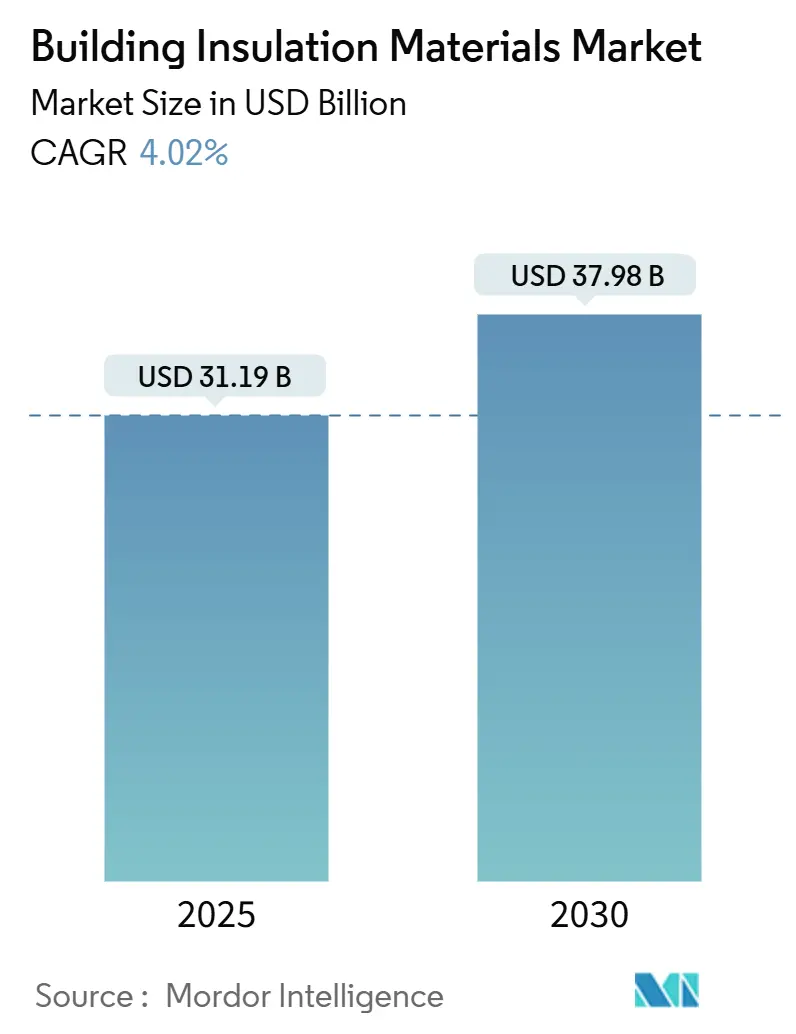
Building Insulation Materials Market Analysis by Mordor Intelligence
The Building Insulation Materials Market size is estimated at USD 31.19 billion in 2025, and is expected to reach USD 37.98 billion by 2030, at a CAGR of 4.02% during the forecast period (2025-2030). Heightened regulatory stringency in Europe and North America, rapid urbanization in Asia-Pacific, and growing homeowner awareness of utility savings are together expanding the addressable base for advanced thermal and acoustic solutions. Material innovation intensifies as manufacturers race to deliver higher R-values in slimmer profiles, lower embodied carbon, and superior fire performance—often within a single product family. Competitive strategies revolve around acquisitions that broaden geographic reach and product scope, illustrated by Owens Corning’s USD 3.9 billion purchase of Masonite International that added complementary building envelope products while promising USD 125 million in cost synergies.
Key Report Takeaways
- By material type, fiberglass led with 35.10% of the building insulation materials market share in 2024, whereas polystyrene is forecast to expand at a 4.24% CAGR through 2030.
- By application, roof installations dominated with a 29.42% revenue share in 2024; acoustic partition and HVAC duct uses are advancing at 4.94% CAGR to 2030.
- By end-user, residential captured 57.18% of the building insulation materials market size and is also the fastest-growing segment at 4.08% CAGR between 2025-2030.
- By installation, new construction accounted for 65% share in 2024, while renovation activities are rising at 5.50% CAGR as incentives target aging stock.
- By region, Europe commanded 38.19% of revenue during 2024; Asia-Pacific is projected to post the highest regional CAGR of 5.01% through 2030.
Global Building Insulation Materials Market Trends and Insights
Drivers Impact Analysis
| Driver | (~) % Impact on CAGR Forecast | Geographic Relevance | Impact Timeline |
|---|---|---|---|
| Growing Demand for Energy Efficient Buildings | +1.20% | North America, Europe | Medium term (2-4 years) |
| Increasing Green Retrofitting Incentives in North America | +0.90% | North America, spillover Europe | Short term (≤ 2 years) |
| Increasing Governemnt Support for the Usage of Eco-Friendly and Sustainable Materials | +0.70% | Global, strongest Europe | Medium term (2-4 years) |
| Growing Preference for Low-VOC Bio-based Foams | +0.50% | North America, Europe | Medium term (2-4 years) |
| Rising Infrastructure and Industrialization in Asia-Pacific | +1.00% | China, India | Long term (≥ 4 years) |
| Source: Mordor Intelligence | |||
Growing demand for energy-efficient buildings
New codes, such as the 2024 International Energy Conservation Code, require R49 attic insulation in US Climate Zones 2-3 and R60 in Zones 4-8, tightening thermal envelope thresholds that push specifiers toward higher-performance products. Across the Atlantic, the revised Energy Performance of Buildings Directive sets a binding 16% reduction in energy use by 2030, reinforcing momentum for upgrades in European housing stock. As commercial owners strive to meet ANSI/ASHRAE/IES 90.1-2022, which yields 9.8% site energy savings versus the 2019 edition, demand is shifting toward materials that deliver equivalent R-values in thinner assemblies to preserve rentable area. Manufacturers are responding with hybrid solutions that pair low-conductivity cores with reflective facers to maximize thermal performance per millimeter.
Increasing green retrofitting incentives in North America
The US Energy Efficient Home Improvement Credit reimburses up to 30% of qualifying insulation expenses, effectively narrowing payback periods for homeowners. Complementary standards for affordable housing are driving significant annual household savings, encouraging adoption among lower-income brackets. These programs coincide with municipal climate plans that mandate energy retrofits for buildings above defined floor-area thresholds, creating a pipeline of projects that sustain material demand through the decade. Manufacturers with blown-in and spray foam systems tailored to retrofit cavities are positioned to capture this incremental volume.
Increasing government support for eco-friendly and sustainable materials
The European mineral wool sector has already cut carbon intensity by 40% since 1990 and targets full climate neutrality by 2050, signaling future preference toward lower-carbon production routes[1]Eurima, “Our 2050 Climate Neutrality Vision,” eurima.org . Incentive funding is also flowing to innovators such as CleanFiber, which secured USD 20 million in Department of Energy grants to scale cellulose insulation sourced from recycled cardboard[2]CleanFiber, “DOE Grant Press Release,” cleanfiber.com . Similar programs prioritize disclosure of environmental product declarations, prompting firms like Knauf Insulation to invest in transparent life-cycle assessments under a USD 3.28 million EPA grant. The result is a broadening portfolio of bio-based and recycled options that meet performance codes while supporting national decarbonization targets.
Growing preference for low-VOC bio-based foams
Formaldehyde-free binder chemistries now underpin fiberglass rolls that carry asthma- and allergy-friendly certification, reflecting higher indoor-air-quality expectations in both residential and commercial projects. Polyurethane suppliers are likewise switching to natural-oil polyols, pairing plant-derived content with blowing agents that eliminate high-GWP HFCs. Early adopters in the HVAC sector are specifying these low-emission foams to protect occupants without sacrificing thermal resistance, a trend that will amplify as disclosure tools such as EPDs become commonplace.
Restraints Impact Analysis
| Restraint | (~) % Impact on CAGR Forecast | Geographic Relevance | Impact Timeline |
|---|---|---|---|
| High Materials and Installation Cost | -0.80% | Developing regions | Short to medium term (≤ 4 years) |
| Availability of Affordable Alternatives | -0.40% | Global | Short term (≤ 2 years) |
| Regulatory Scrutiny on Global Warming Potential of Blowing Agents | -0.60% | Global, with strongest impact in Europe and North America, moderate impact in Asia-Pacific | Medium term (2-4 years) |
| Source: Mordor Intelligence | |||
High materials and installation cost
Many price-sensitive markets still perceive advanced systems such as aerogel blankets as cost-prohibitive despite superior thermal resistance, because specialized handling elevates total installed cost. Capital constraints in large-scale social housing programs further dampen momentum for premium products, forcing specifiers to revert to mid-range fiberglass or polystyrene even when lifecycle savings justify higher outlays. Until manufacturing scale lowers unit price or incentives bridge the gap, premium materials will remain confined to niche projects where performance drives specification.
Availability of affordable alternatives
Fiberglass batts and loose-fill cellulose meet minimum code requirements at the lowest installed cost, which keeps them popular with DIY renovators and small contractors. Their market presence moderates penetration of higher-priced foams despite the latter’s continuous coverage advantage. The disparity is most visible in regions with milder climates where simple R-value compliance outweighs advanced moisture or acoustic performance. This entrenched adoption of conventional formats will continue to temper premium category gains through the first half of the forecast period.
Segment Analysis
By Material Type: Evolving performance priorities diversify the mix
Fiberglass held 35.10% of the building insulation materials market in 2024, anchored by long-established supply chains and competitive pricing. Its glass-fiber core delivers reliable thermal resistance and non-combustibility, making it a staple across climate zones. Polystyrene is the fastest climber at 4.24% CAGR thanks to capacity expansions such as BASF’s upgrade in Ludwigshafen that improves bead consistency and thermal performance. Mineral wool retains traction where fire rating and sound attenuation are paramount, while cellulose growth rides sustainability credentials and regional programs that value recycled content. PUR and PIR foams address premium applications requiring high R-value per inch, yet their share is checked by cost and flammability perceptions. Aerogels remain niche but could disrupt as costs fall due to process improvements that shorten supercritical drying cycles.
Cost, embodied-carbon targets and tightening fire regulations now shape specification more than R-value alone. This shift is creating space for hybrid panels that laminate different cores to combine strengths such as moisture tolerance and structural rigidity. Manufacturers are investing in binder chemistries that lower formaldehyde and phenol emissions, anticipating stricter indoor-air-quality standards. As a result, the building insulation materials market sees parallel tracks: mature commodities stabilize on volume, while high-performance classes grow faster albeit from a smaller base.
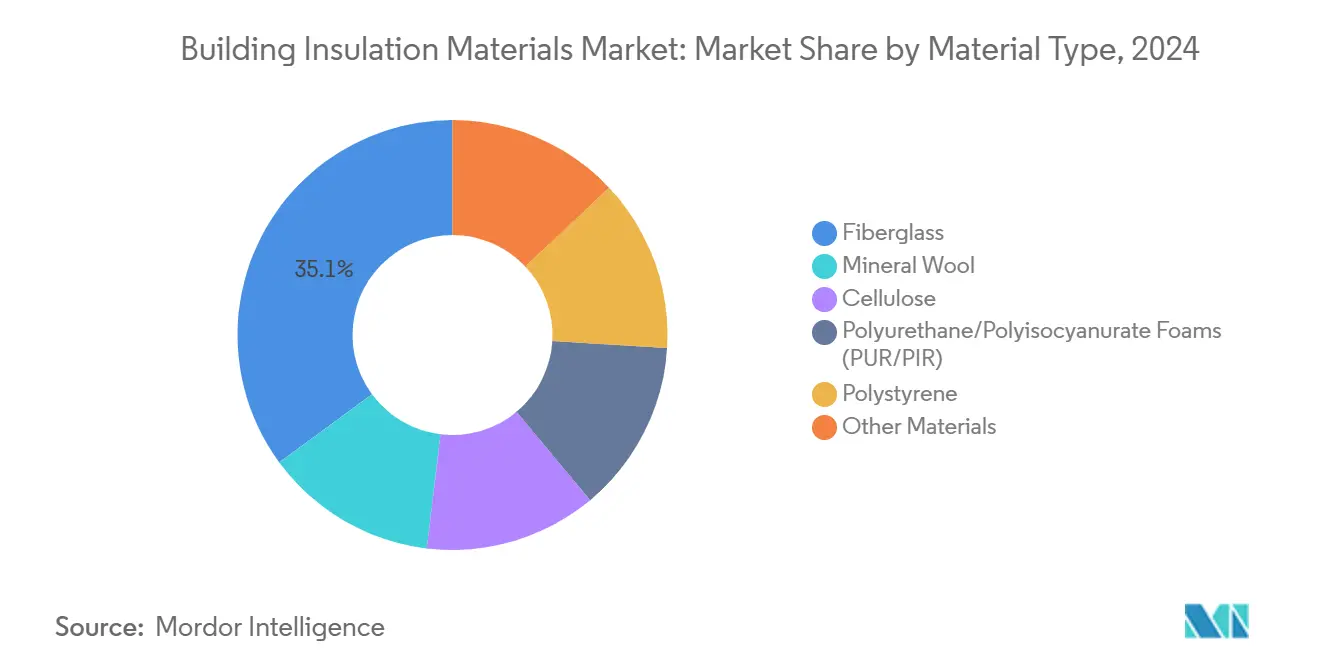
Note: Segment shares of all individual segments available upon report purchase
By Application: Roof remains core, acoustics accelerate
Roof assemblies captured 29.42% of 2024 revenue because heat-flux concentration through the top of the envelope makes them the first target for energy upgrades. Installation is comparatively straightforward, and subsidies for solar-ready roofs often bundle thermal packages, which sustains volume. The building insulation materials market size for acoustic partition and HVAC ducts is forecast to expand at a 4.94% CAGR to 2030 as health authorities recognize noise pollution as a public health issue. Wall cavities and external insulation finish systems follow closely because renovation programs prioritize façade upgrades that boost both aesthetics and thermal performance. Floor and basement solutions grow in colder climates where slab-edge losses weaken overall envelope performance.
Integrated design is gaining ground: architects specify systems that address thermal, acoustic and moisture objectives simultaneously to simplify detailing and shorten construction schedules. This holistic mindset drives demand for multi-functional boards that eliminate puncture-prone vapor barriers or incorporate acoustic mats. Consequently, product messaging increasingly highlights system compatibility rather than stand-alone thermal metrics, reinforcing a consultative selling approach among leading suppliers.
By End-User: Residential demand leads and sustains growth
Residential owners commanded 57.18% of the building insulation materials market share in 2024 and are projected to continue growing at 4.08% CAGR through 2030, supported by direct utility-bill savings and attractive payback periods. Consumer-facing rebates and financing products lower upfront cost barriers, while raised awareness of indoor-air quality boosts interest in low-VOC and formaldehyde-free options. Commercial buildings follow as corporations chase net-zero commitments and ESG scoring, often stipulating environmental product declarations and cradle-to-gate carbon thresholds during procurement.
Infrastructure and industrial segments add steady but specialized demand for high-temp or vibration-resistant solutions; however, their cumulative volume remains modest compared with housing and offices. Industrial buyers prioritize longevity and process safety, resulting in thicker mineral wool or cellular glass that withstands process temperatures. Over the outlook period, rising hybrid-work models may moderate new office construction, but retrofit cycles in existing stock will offset this drag, keeping commercial volume stable.
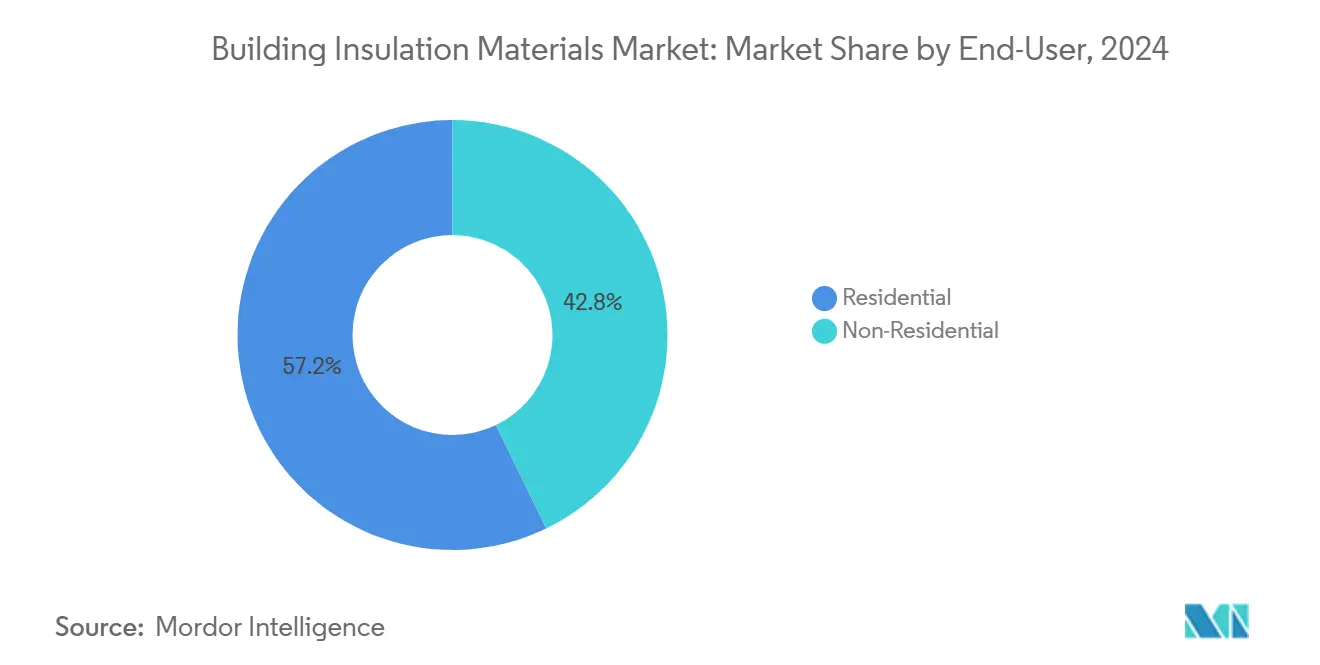
By Installation: Renovation accelerates in legacy stock
New construction accounted for 65% of 2024 volume as modern codes embed insulation into initial designs. Even so, renovation projects are growing faster at 5.50% CAGR because policy makers see retrofits as the quickest path to emission cuts in hard-to-decarbonize building stock. The building insulation materials market size allocated to retrofit blown-in systems is rising, since these products fill irregular cavities without invasive demolition. Contractors favor loose-fill fiberglass and cellulose for attics and wall voids owing to low equipment cost and rapid coverage. Panelized systems with integrated air-barrier layers are emerging for exterior re-cladding that upgrades appearance and performance in one step.
Labor shortages push manufacturers to simplify installation through pre-scored batts, interlocking edges and adhesive strips that reduce fastening hardware. Digital tools—such as thermal imaging and laser measurement—are streamlining pre-retrofit diagnostics, cutting project time and helping contractors document incentive compliance. These efficiency gains further strengthen the economic case for upgrading heritage buildings despite higher baseline material costs.
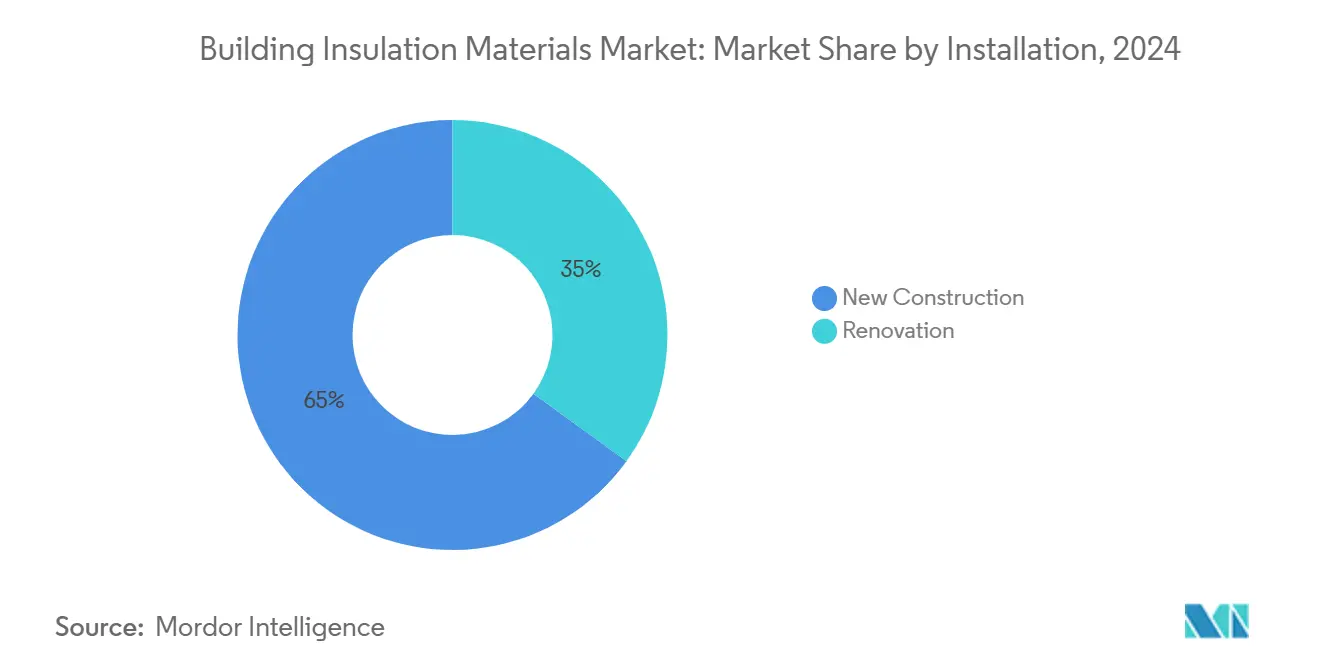
Geography Analysis
Europe maintained 38.19% share in 2024, driven by binding climate legislation that targets a 60% emission cut in buildings by 2030 and a zero-emission stock by 2050. National transposition of the directive accelerates demand for exterior insulation and finish systems, mineral wool, and high-performance rigid boards. Producers are scaling regional capacity, evidenced by Knauf’s GBP 172 million rock mineral wool factory in the United Kingdom that will start operations in 2026.
Asia-Pacific is the fastest-growing region with a 5.01% CAGR to 2030 as China, India, and Southeast Asian markets align local codes with international best practice. Government stimulus for efficient appliances and green buildings reinforces underlying demographic demand from rapid urbanization. Capacity additions such as Rockwool’s Tamil Nadu plant shorten lead times and localize pricing, which improves adoption in cost-sensitive segments.
North America combines a steady new-build pipeline with robust retrofit activity catalyzed by federal tax credits and utility rebates. Market interest is shifting to lower-VOC products, spurring material substitution in HVAC ducts and occupied spaces. Corporate ESG disclosure rules are advancing environmental transparency, favoring suppliers that can prove low embodied carbon through verified EPDs.
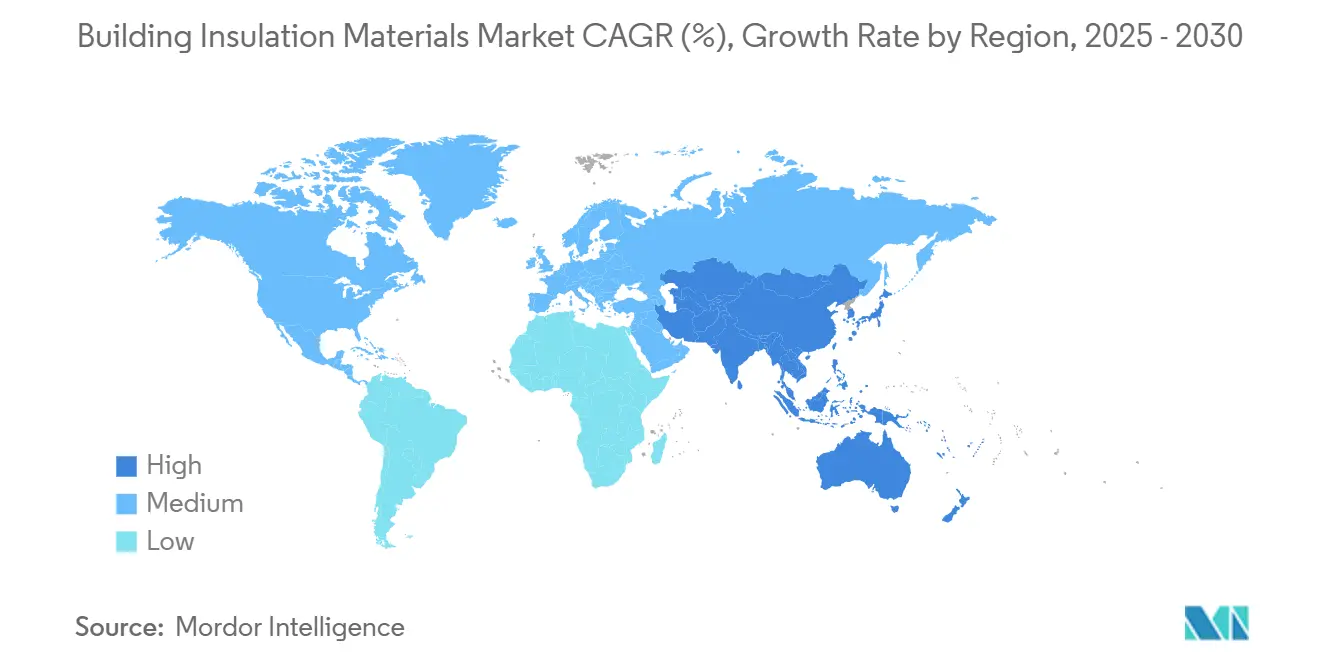
Competitive Landscape
The building insulation materials market remains moderately fragmented. Owens Corning’s Masonite deal elevated its annual revenue base to USD 12.5 billion and integrated door and envelope components that broaden cross-selling potential. Holcim moved to purchase OX Engineered Products, adding structural sheathing and continuous insulation that complement its broad construction materials portfolio[3]Holcim, “Holcim to Acquire OX Engineered Products,” holcim.com .
Innovation is an equally critical differentiator. BASF’s Slentite polyurethane panel achieves comparable R-values with half the thickness of traditional boards, catering to architects seeking slim profiles in high-density urban projects. Knauf, Rockwool, and Kingspan are committing capital to scale lower-carbon production, and several are trialing electric or hydrogen-fired melting furnaces for mineral wool to cut Scope 1 emissions.
Specialty entrants focus on bio-based niches: mycelium composites, hemp fiber boards and recycled textile panels. Although current volumes are small, partnerships with major distributors are extending market reach. The pace of environmental regulation suggests that premium sustainable products will transition from optional upgrades to standard specifications in segments such as schools, hospitals and public housing.
Building Insulation Materials Industry Leaders
-
Owens Corning
-
Saint-Gobain
-
ROCKWOOL A/S
-
Kingspan Group
-
Knauf Group
- *Disclaimer: Major Players sorted in no particular order
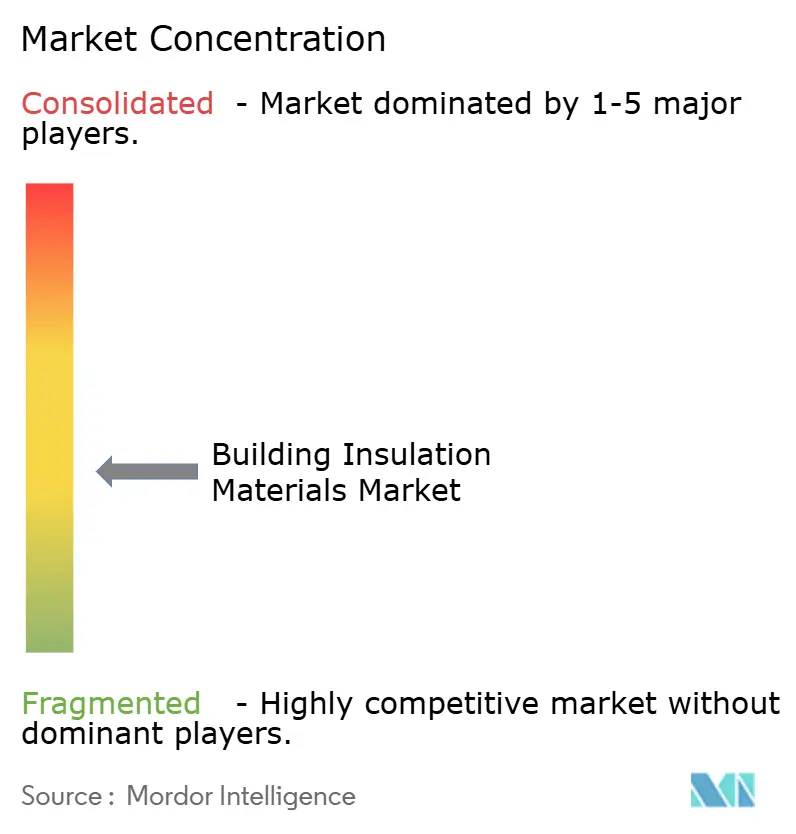
Recent Industry Developments
- July 2024: Knauf Insulation secured a USD 3.28 million grant from the EPA to advance the development of Environmental Product Declarations (EPDs) for its insulation products. This initiative aims to enhance transparency and sustainability in the building insulation materials market, shaping consumer choices and regulations.
- May 2024: Knauf Insulation introduced its new product line, Knauf Performance+, which is the first HVAC fiberglass insulation to receive certification as asthma & allergy friendly and to be formaldehyde-free. This innovation is set to advance the building insulation materials market by meeting the demand for sustainable and healthier solutions.
Global Building Insulation Materials Market Report Scope
Building insulation materials are the building materials that reduce heat transfer and form a thermal envelope for the building. Building insulation materials contribute significantly to reducing energy consumption in buildings and sustain the affordability of the construction industry by improving the cost of energy and performance in the building envelope (walls, roofs, floors, etc.), windows, mechanical systems, as well as on-site renewable generation and thermal systems. Building insulation is a material that prevents heat or sound from being transmitted from one area to another. Building insulation is mainly for thermal and acoustic purposes. However, it is also used for impact resistance and fire insulation.
The building insulation materials market is segmented by type, end-user industry, and geography. The market is segmented by types into fiberglass, mineral wool, cellulose, polyurethane/ polyisocyanurate (PUR/PIR) foam, polystyrene, and other insulation materials (hemp, straw, etc.). By end-user industry, the market is segmented into residential and non-residential. The report also covers the market sizes and forecasts for the building insulation materials market in 27 countries across major regions. For each segment, the market sizing and forecasts are provided in terms of revenue (USD).
| Fiberglass |
| Mineral Wool |
| Cellulose |
| Polyurethane/Polyisocyanurate Foams (PUR/PIR) |
| Polystyrene |
| Other Materials (Cork, Aerogel and Vacuum Insulation Panels, Spray Foams, Hemp, Calcium-Silicate, etc.) |
| Roof |
| Wall (External and Cavity) |
| Floor and Basement |
| Ceiling and Attic |
| Acoustic Partition and HVAC Duct |
| Residential | |
| Non-Residential | Commercial |
| Infrastructure | |
| Other Non-Residential Industries (Education, Healthcare, Civic and Religious,etc.) |
| New Construction |
| Renovation |
| Asia-Pacific | China |
| India | |
| Japan | |
| South Korea | |
| ASEAN Countries | |
| Rest of Asia-Pacific | |
| North America | United States |
| Canada | |
| Mexico | |
| Europe | Germany |
| United Kingdom | |
| France | |
| Italy | |
| Spain | |
| Nordics Countries | |
| Rest of Europe | |
| South America | Brazil |
| Argentina | |
| Rest of South America | |
| Middle East and Africa | Saudi Arabia |
| South Africa | |
| Rest of Middle East and Africa |
| By Material Type | Fiberglass | |
| Mineral Wool | ||
| Cellulose | ||
| Polyurethane/Polyisocyanurate Foams (PUR/PIR) | ||
| Polystyrene | ||
| Other Materials (Cork, Aerogel and Vacuum Insulation Panels, Spray Foams, Hemp, Calcium-Silicate, etc.) | ||
| By Application | Roof | |
| Wall (External and Cavity) | ||
| Floor and Basement | ||
| Ceiling and Attic | ||
| Acoustic Partition and HVAC Duct | ||
| By End-User | Residential | |
| Non-Residential | Commercial | |
| Infrastructure | ||
| Other Non-Residential Industries (Education, Healthcare, Civic and Religious,etc.) | ||
| By Installation | New Construction | |
| Renovation | ||
| By Geography | Asia-Pacific | China |
| India | ||
| Japan | ||
| South Korea | ||
| ASEAN Countries | ||
| Rest of Asia-Pacific | ||
| North America | United States | |
| Canada | ||
| Mexico | ||
| Europe | Germany | |
| United Kingdom | ||
| France | ||
| Italy | ||
| Spain | ||
| Nordics Countries | ||
| Rest of Europe | ||
| South America | Brazil | |
| Argentina | ||
| Rest of South America | ||
| Middle East and Africa | Saudi Arabia | |
| South Africa | ||
| Rest of Middle East and Africa | ||
Key Questions Answered in the Report
What is the current size of the building insulation materials market?
It is valued at USD 31.19 billion in 2025 and is projected to grow to USD 37.98 billion by 2030.
Which material type leads global sales?
Fiberglass accounts for 35.10% of 2024 revenue, driven by cost efficiency and mature supply chains.
Why is renovation demand rising faster than new-build demand?
Government incentives and updated energy codes are accelerating upgrades to the existing building stock, leading to a 5.50% CAGR for renovation installations through 2030.
Which region is expanding most rapidly?
Asia-Pacific shows the fastest regional CAGR at 5.01%, supported by urbanization and local capacity additions.
How are sustainability trends influencing material choices?
Regulations and voluntary programs favor low-VOC, recycled and bio-based options, prompting manufacturers to commercialize formaldehyde-free fiberglass, cellulose and mycelium panels.
Page last updated on:



